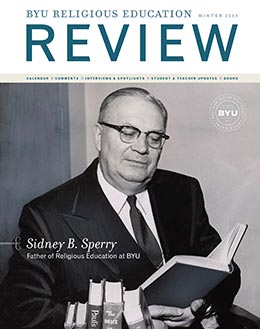Studia Antiqua
Student Section
Student Journal Explores the Ancient World
Joining the Church at age twenty changed the life of Daniel O. McClellan. A year later, while serving a mission, he became fascinated with Hebrew and decided to make it his life’s goal to study the Bible in its original languages. He decided to major in ancient Near Eastern studies and joined the Students of the Ancient Near East (SANE) organization at BYU. The organization sponsors faculty lectures twice a month and other symposia on the ancient world. In the process of these gatherings, the students heard about a defunct journal called Studia Antiqua started by BYU student Matthew J. Grey in 2002. They began seeking funding to bring it back to life.
Breanne White spearheaded the effort, serving as editor in chief. Dan volunteered as an associate editor while it was under the umbrella of the Humanities Publication Center. Breanne moved on to other projects, and Dan was made editor in chief in 2007. At that time, BYU’s Council for Religious Endeavors (CORE) decided the student journal needed a sponsoring entity on campus to keep it alive and vibrant. Terry B. Ball, dean of Religious Education, asked Dr. Richard Neitzel Holzapfel, Religious Studies Center publications director, to oversee the journal and ensure its vitality. Michael D. Rhodes, professor of ancient scripture, has served as faculty adviser since then. Dr. Dana Pike, the Ancient Near Eastern Studies coordinator, says that Dan is “enthusiastic and hardworking, and he has raised the quality of the journal.”
Dan is mentored in his editing by executive editor Devan Jensen, who recognizes this as an important part of his job. President Cecil O. Samuelson said to BYU faculty and staff, “No one is doing a job only to get it done, although such is essential. Every interaction with a student is a way for him or her to be trained” (“Citizenship, Research, Teaching: The BYU Way,” August 26, 2008, 12, http://
Studia Antiqua fills an important niche on campus and beyond. It assists students from the various disciplines of ancient studies (classics, ancient Near Eastern studies, anthropology, and art history) to publish and gain experience in their field in preparation for graduate studies and professional careers. Students can submit their articles to studia_antiqua@byu.edu. Dan offers this advice to potential authors: “Many of the articles we accept for publication have been written in connection with a class or have been cowritten with a professor. Any mentoring help from faculty or peers in their field will make their submissions stronger and even more likely to be published.”
One example of an outstanding article is David Lurth’s exegetical review of the Hebrew term “strangers in the land” and ancient Israel’s covenantal responsibility to care for foreigners and other disadvantaged peoples. Another example is Scott Preston Sukhan Nibley’s examination of the phrase “Have ye inquired of the Lord?” Nibley notes that divine inquiry patterns pervade the Bible and the Book of Mormon, and his paper outlines a ritual backdrop that can be detected in both texts.
The future of Studia Antiqua is bright. The Religious Studies Center has provided an internship for the editor in chief to guarantee the continuity of the journal, and funding has almost doubled since the journal was reestablished. Dr. Pike says, “Studia Antiqua provides our BYU students with a great opportunity to publish their research and writing. This is great career preparation; it’s also very rewarding for them. I really appreciate the RSC’s support of this student journal.”
